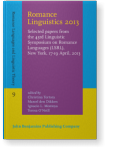Affirmative polar replies in Brazilian Portuguese
This article analyzes affirmative polar replies in Brazilian and European Portuguese (BP/EP), which may consist of just the inflected verb or some polar item. These polar replies have been analyzed as instances of null subjects and VP-Ellipsis. This analysis is untenable for BP, as this variety has been losing categorical null referential subjects since the 19th century. The analysis that will be pursued here, for both BP and EP, is an adaptation of the one proposed in Holmberg (2001) for Finnish, according to which, in simple affirmative answers, which consists of just the inflected verb, the verb moves to a pre-sentential position, followed by Remnant TP-Ellipsis. But BP also differs from Finnish when more complex answers are at stake. With regard to the position and optionality of the affirmative polar item sim (yes), a comparison will be made with Japanese, a language identical to BP with regard to affirmative PRs.
References (30)
References
Barbosa, Pilar, Maria Eugênia Duarte, and Mary A. Kato. 2005. “Null Subjects in European and Brazilian Portuguese.” In Journal of Portuguese Linguistics. 4(2): 11-52.
Chomsky, Noam. 1981. Lectures on Government and Binding. Dordrecht: Foris Publications.
Cinque, Guglielmo. 1999. Adverbs and Functional Heads. New York: Oxford University Press.
Costa, João, Ana Maria Martins, and Fernanda Pratas. 2012. “VP-Ellipsis: New Evidence from Capeverdean.” In Romance Languages and Linguistic Theory, ed. by Irene Franco, Sara Lusini and Andrés Saab, 155-175. Amsterdam: John Benjamins. 

Duarte, Maria Eugênia. 2005. A Perda do Princípio “Evite pronome” no Português Brasileiro. Ph.D. Dissertation. UNICAMP.
Ferreira, Marcelo. 2004. “Hyperraising and Null Subjects in Brazilian Portuguese.” MIT Working Papers in Linguistics 47: Collected Papers on Romance Syntax. 57-85.
Holmberg, Anders. 2001. “The Syntax of Yes and No in Finnish.” Studia Linguistica 55:141-175. 

Holmberg, Anders. 2005. “Is There a Little pro? Evidence from Finnish.” Linguistic Inquiry 36: 533-564. 

Holmberg, Anders. 2006. “Null Subjects and Polarity Focus.” Studia Linguistica 61(3): 212- 236. 

Huang, James C.T. 1984. “On the Distribution and Reference of Empty Pronouns.” Linguistic Inquiry 15: 531-574.
Kato, Mary A. 1999. “Strong Pronouns and Weak Pronominals in the Null Subject Parameter.” PROBUS, (11)1: 1-37. Berlin, Editora Mouton de Gruyter. 

Kato, Mary A. 2000. “The Partial Pro-Drop Nature and the Restricted VS Order in Brazilian Portuguese.” In The Null Subject Parameter In Brazilian Portuguese, ed. by Mary A. Kato and Esmeralda Negrão, 223-258.
Kato, Mary A. 2009. “O Sujeito Nulo Revisitado no Português Brasileiro.” In História do Português Paulista, Vol. 2, ed. by M.A. Torres-Moraes and M.L.O. de Andrade, 61-82. Campinas: Editora da UNICAMP. 
Kato, Mary A. 2010. “Clivadas sem Operador no Português Brasileiro.” Estudos da Língua (gem). 8(2): 61-77. Vitoria da Conquista.
Kato, Mary A. 2014. “The Role of the Copula in the Diachronic Development of Focus Constructions in Brazilian Portuguese.” In Variation within and Across Romance Languages: Selected Papers from the 41st Linguistic Symposium on Romance Languages (LSRL), Ottawa, 5–7 May 2011, ed. by Côté, Marie-Hélène and Eric Mathieu, 297–314.
Kato, Mary A. and Esmeralda V. Negrão (eds.). 2000. Brazilian Portuguese and the Null Subject Parameter. Frankfurt: Vevuert/Iberoamericana.
Kato, Mary A. and Fernando Tarallo. 1992. “Sim: Respondendo Afirmativamente em Português.” In Linguística Aplicada: da Aplicação a Lingüística para uma Lingüística Transdisciplinar, ed. by M.S.Z. de Paschoal and M.A.A. Celani. São Paulo: EDUC.
Kayne, Richard. 1998. “Overt vs. Covert Movement.” Syntax 1: 128-191.Kayne, Richard and Jean-Yves Pollock. 2001. “New Thoughts on Stylistic Inversion.” In Inversion in Romance and the Theory of Universal Grammar, ed. by Aafke Hulk and Jean-Yves Pollock, 107-162. New York: Oxford University Press.
MacCloskey, James. 1991. “Clause Structure, Ellipsis, and Proper Government in Irish.” Lingua 85: 259-302. 

Martins, Ana Maria. 1994. “Enclisis, VP-Deletion and the Nature of Sigma.” PROBUS 6. 2-3: 173-206. 

Matos, Gabriela. 1992. Construçoes de Elipse do Predicado em Português – SV Nulo e Despojamento. Ph.D. Dissertation. University of Lisbon.
Modesto, Marcello. 2000. On the Identification of Null Arguments. Ph.D. Dissertation. University of Southern California.
Nunes, Jairo. 2004. Linearization of Chains and Sideward Movement.Cambridge and London: MIT Press. 
Oliveira, Marilza. 2000. “The Pronominal Subject in Italian and Brazilian Portuguese.” In The Null Subject Parameter In Brazilian Portuguese, ed. by Mary A. Kato and Esmeralda Negrão, 37-54.
Raposo, Eduardo. 1994. “Affective Operators and Clausal Structure in EuropeanPortuguese and European Spanish.” Paper presented at the 24th LSRL, UCLA/USC.
Rerisson, Cavalcante. 2012. Negação Anafórica no Português Brasileiro: Negação Sentencial, Negação Enfática e Negação de Constituinte. USP: Ph.D. Dissertation. 
Rizzi, Luigi. 1982. Issues in Italian Syntax. Dordrecht: Foris. 

Rizzi, Luigi. 1997. “The Fine Structure of the Left Periphery.” In Elements of Grammar, ed. by Liliane Haegeman, 281-337. Dordrecht: Kluwer. 

Sell, Fabíola Sucupira Ferreira. 2003. As Interrogativas do Português Brasiliero: Perguntas e Respostas. UFSC: Ph.D. Dissertation.
Cited by (2)
Cited by two other publications
Mendes, Gesoel & Marta Ruda
This list is based on CrossRef data as of 25 july 2024. Please note that it may not be complete. Sources presented here have been supplied by the respective publishers.
Any errors therein should be reported to them.
